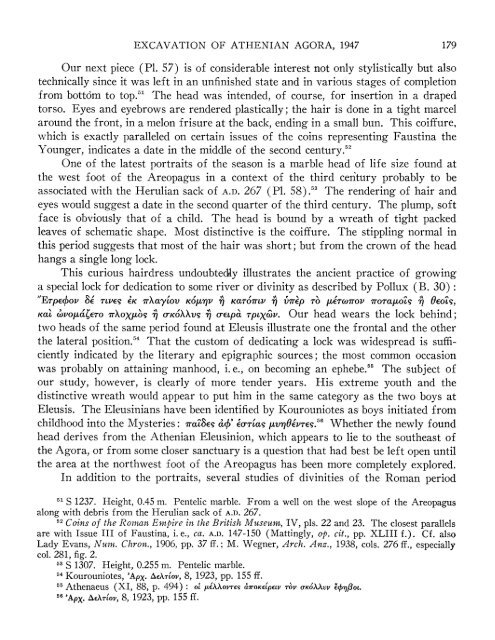the excavation of the athenian agora twelfth season: 1947
the excavation of the athenian agora twelfth season: 1947
the excavation of the athenian agora twelfth season: 1947
Create successful ePaper yourself
Turn your PDF publications into a flip-book with our unique Google optimized e-Paper software.
EXCAVATION OF ATHENIAN AGORA, <strong>1947</strong> 179<br />
Our next piece (P1. 57) is <strong>of</strong> considerable interest not only stylistically but also<br />
technically since it was left in an unfinished state and in various stages <strong>of</strong> completion<br />
from bottom to top.51 The head was intended, <strong>of</strong> course, for insertion in a draped<br />
torso. Eyes and eyebrows are rendered plastically; <strong>the</strong> hair is done in a tight marcel<br />
around <strong>the</strong> front, in a melon frisure at <strong>the</strong> back, ending in a small bun. This coiffure,<br />
which is exactly paralleled on certain issues <strong>of</strong> <strong>the</strong> coins representing Faustina <strong>the</strong><br />
Younger, indicates a date in <strong>the</strong> middle <strong>of</strong> <strong>the</strong> second century.52<br />
One <strong>of</strong> <strong>the</strong> latest portraits <strong>of</strong> <strong>the</strong> <strong>season</strong> is a marble head <strong>of</strong> life size found at<br />
<strong>the</strong> west foot <strong>of</strong> <strong>the</strong> Areopagus in a context <strong>of</strong> <strong>the</strong> third cen'tury probably to be<br />
associated with <strong>the</strong> Herulian sack <strong>of</strong> A.D. 267 (P1. 58).5 The rendering <strong>of</strong> hair and<br />
eyes would suggest a date in <strong>the</strong> second quarter <strong>of</strong> <strong>the</strong> third century. The plump, s<strong>of</strong>t<br />
face is obviously that <strong>of</strong> a child. The head is bound by a wreath <strong>of</strong> tight packed<br />
leaves <strong>of</strong> schematic shape. Most distinctive is <strong>the</strong> coiffure. The stippling normal in<br />
this period suggests that most <strong>of</strong> <strong>the</strong> hair was short; but from <strong>the</strong> crown <strong>of</strong> <strong>the</strong> head<br />
hangs a single long lock.<br />
This curious hairdress undoubted'ly illustrates <strong>the</strong> ancient practice <strong>of</strong> growing<br />
a special lock for dedication to some river or divinity as described by Pollux (B. 30):<br />
'ETpEov 8E' TWE9 EK IXaytXOV KO/L7)V 7) KaTowtv P VTEp TO ET0TOV voTa/otg X 0EOS,<br />
KaG VOUa O LL ETO 1ATXOX,uo9<br />
'<br />
77 cTKoXXV19 OTEL' rptyc,v.<br />
Our head wears <strong>the</strong> lock behind;<br />
two heads <strong>of</strong> <strong>the</strong> same period found at Eleusis illustrate one <strong>the</strong> frontal and <strong>the</strong> o<strong>the</strong>r<br />
<strong>the</strong> lateral position.54 That <strong>the</strong> custom <strong>of</strong> dedicating a lock was widespread is suffi-<br />
ciently indicated by <strong>the</strong> literary and epigraphic sources; <strong>the</strong> most common occasion<br />
was probably on attaining manhood, i. e., on becoming an ephebe.55 The subject <strong>of</strong><br />
our study, however, is clearly <strong>of</strong> more tender years. His extreme youth and <strong>the</strong><br />
distinctive wreath would appear to put him in <strong>the</strong> same category as <strong>the</strong> two boys at<br />
Eleusis. The Eleusinians have been identified by Kourouniotes as boys initiated from<br />
childhood into <strong>the</strong> Mysteries: wTat83Eg a+' EorTiag 1%v770EvTEq.56 Whe<strong>the</strong>r <strong>the</strong> newly found<br />
head derives from <strong>the</strong> A<strong>the</strong>nian Eleusinion, which appears to lie to <strong>the</strong> sou<strong>the</strong>ast <strong>of</strong><br />
<strong>the</strong> Agora, or from some closer sanctuary is a question that had best be left open until<br />
<strong>the</strong> area at <strong>the</strong> northwest foot <strong>of</strong> <strong>the</strong> Areopagus has been more completely explored.<br />
In addition to <strong>the</strong> portraits, several studies <strong>of</strong> divinities <strong>of</strong> <strong>the</strong> Roman period<br />
51 S 1237. Height, 0.45 m. Pentelic marble. From a well on <strong>the</strong> west slope <strong>of</strong> <strong>the</strong> Areopagus<br />
along with debris from <strong>the</strong> Herulian sack <strong>of</strong> A.D. 267.<br />
52 Coins <strong>of</strong> <strong>the</strong> Roman Empire in <strong>the</strong> British Museum, IV, pls. 22 and 23. The closest parallels<br />
are with Issue III <strong>of</strong> Faustina, i. e., ca. A.D. 147-150 (Mattingly, op. cit., pp. XLIII f.). Cf. also<br />
Lady Evans, Numin. Chron., 1906, pp. 37 ff.; M. Wegner, Arch. Anz., 1938, cols. 276 ff., especially<br />
col. 281, fig. 2.<br />
53 S 1307. Height, 0.255 m. Pentelic marble.<br />
Kourouniotes, 'ApX. Ackn'ov, 8, 1923, pp. 155 ff.<br />
55 A<strong>the</strong>naeus (XI, 88, p. 494): ot iAdXov7r-s aIrOKK pEL TOv oYKO'XXVV fr?POq.<br />
5 'ApX. AeXvTov, 8, 1923, pp. 155 if.

















